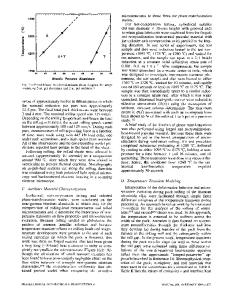Kinetics of low-temperature pack aluminide coating formation on alloy steels
- PDF / 199,002 Bytes
- 7 Pages / 612 x 792 pts (letter) Page_size
- 5 Downloads / 309 Views
pack cementation process is essentially an in-situ chemical vapor deposition (CVD) process normally used to aluminize nickel-base superalloys or steels to enhance their high-temperature oxidation and corrosion resistance.[1–4] The process is simple to operate and easy to apply to coat components of various dimensions and complex geometries. It is particularly suited to coat the internal surface of metal tubes. A number of fundamental studies have been carried out to systematically determine the effect of pack chemistry and processing condition on the growth kinetics of aluminide coatings on metal alloys for high-temperature applications. Particularly noticeable are those reported by Levin and Cave on a nickel-base superalloy at 982 °C to 1149 °C;[5] Seigle and co-workers on nickel, Ni-Cr alloys, and pure iron at 800 °C to 1150 °C;[6–9] Kung and Rapp on pure iron at 900 °C;[10] Akuezue and Stringer on Fe-Cr alloys at 850 °C to 1000 °C;[11] Soliman et al. on carbon steels at 750 °C to 900 °C;[12] Levin et al. on pure iron at 700 °C to 900 °C;[13] and Xiang et al. on a nickel-base superalloy at 800 °C to 1100 °C.[3] It can be noted that nearly all of these previous studies were made at temperatures above 750 °C. This presents no concerns for nickelbase superalloys. However, for alloy steels such as the (9-12)Cr-1Mo (wt pct) type of alloy steels used widely in steam turbine power generators, thermal treatment for long periods at these temperatures, normally lasting 6 to 30 hours for a pack aluminizing cycle, can seriously degrade the strength and creep resistance of these alloys as a result Z.D. XIANG, Reader, School of Computing, Engineering and Information Sciences, Northumbria University, Newcastle upon Tyne, NE1 8ST, United Kingdom, is Professor, School of Materials and Metallurgy, Wuhan University of Science and Technology, Wuhan 430081, People’s Republic of China, and School of Materials Sciences and Engineering, Nanjing University of Science and Technology, Nanjing 210094, People’s Republic of China. Contact e-mail: [email protected] or zhidongxiang@ hotmail.com P.K. DATTA, formerly Professor, School of Computing, Engineering and Information Sciences, Northumbria University, NE1 8ST, United Kingdom, is now retired. Manuscript submitted September 17, 2005. METALLURGICAL AND MATERIALS TRANSACTIONS A
of grain coarsening and carbide precipitation.[14,15] To preserve the microstructure and hence prevent such degradation in mechanical properties, the pack cementation process must be performed at temperatures below 700 °C for these alloys. It is thus somewhat surprising to find that almost no studies are available in the literature on pack aluminizing alloy steels in this temperature range. This study was thus carried out at temperatures below 700 °C to systematically investigate the effects of pack aluminizing conditions on the growth kinetics of iron aluminide coatings on a commercial 9Cr-1Mo (wt pct) type of alloy steel developed to provide sufficient strength and creep resistance for critical structural appli
Data Loading...











